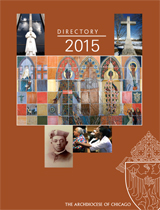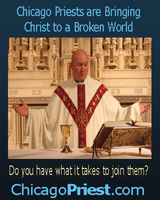May 24, 2009
Teaching ‘Catholic answer’ to sexual revolution
Jennifer Haggerty and Kevin Czarnecki weren’t trying to make St. John Vianney in Northlake the first Catholic school in the archdiocese to teach a theology of the body course to grade school students.
It just happened that way after they attended a briefing for Catholic school teachers last year on a course using materials by Catholic author/educator Christopher West and Jason and Crystalina Evert and Brian Butler based on a series of lectures by Pope John Paul II on sexuality, chastity, the Christian idea of marriage, the human person and relationships from a Catholic perspective.
“It was just something that needed to be addressed quickly,” especially since a majority of the kids will be moving on to public high schools,” where this kind of material won’t be taught, Haggerty said.
While there were abstinenceoriented courses such as the Project Reality Game Plan program, funded until recently by the federal government, they lacked the “faith dimension,” seventh-grade teacher Czarnecki said.
West’s course, Haggerty said, “doesn’t just teach what the church says we can and cannot do, but why we were created and what we were created to do, which is to get to heaven and bring as many others with us as possible.”
Swimming upstream
From their return from Easter break to the end of school, St. John Vianney’s eighth graders will be spending about 40 minutes a day, five days a week, covering what Haggerty called “the Catholic answer” to the secular sexual revolution.
Despite their theology of the body teacher training and about eight hours of DVDs, text books and materials for parents paid for by the archdiocesan Respect Life office and an anonymous donor, Haggerty and Czarnecki admit it sometimes seems like they’re swimming against a strong current.
“I fight with my eighth graders all the time about makeup. One girl at confirmation last night had a really low-cut dress on. They live in a society that’s telling them to wear this stuff.” said Haggerty, who says the message of the course is needed more than ever at a time when she says one of every two marriages, for example, ends in divorce.
And the good news is that Haggerty can tell she’s reaching her students “just by looking at the way they’re staring at you with their mouths open.
“They want to know what they can do, and how far is too far,” Haggerty said.
“The DVD’s begin with a love story about two teenagers who really like each other and aren’t sure what to do about it. It gets into the difference between love and lust,” and it’s also gotten the parents’ attention, she said, recalling how after a mandatory parent/teacher conference on the course, one parent told her and Czarnecki “If only I had been presented with this when I was 13, 14 or 15 years old.”
“That was our affirmation that we were doing what we were supposed to be doing,” Haggerty said.
If there’s one message she’d like to pass on to her students at the end of the course, it’s “don’t settle for anything less.”
Beyond the classroom
But the kids and the parents weren’t the only ones affected by theology of the body, Haggerty and Czarnecki agreed.
“The teachings of JP2 have definitely altered my perspective on human love and sexuality in many ways and given me a deeper appreciation and understanding of my own sexuality,” which Haggerty said embraces a lot more than the subject of sex itself.
“My own outlook on seeing myself, on seeing the world at large is one of hope” as a result of exposure to the Theology of the Body teachings, Czarnecki agreed.
“It’s easy to give in to despair and rage at the state of the world at times, but to do that would be to give up Christ’s message of mercy and compassion. Like any honest educator, I would never presume to see the fruits of my labor. But I can tell you I am more and more excited about the labor when I imagine the possible fruits,” he said.
 Catholic
New World - Newspaper for the Archdiocese of Chicago
Catholic
New World - Newspaper for the Archdiocese of Chicago Archdiocese of Chicago Directory
Archdiocese of Chicago Directory Oficjalne wydawnictwo Archidiecezji Chicago w języku polskim
Oficjalne wydawnictwo Archidiecezji Chicago w języku polskim